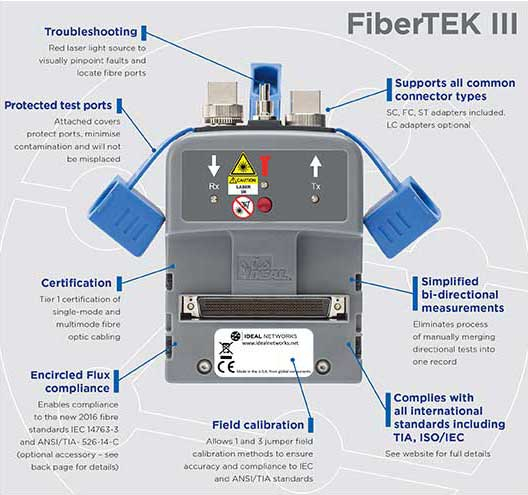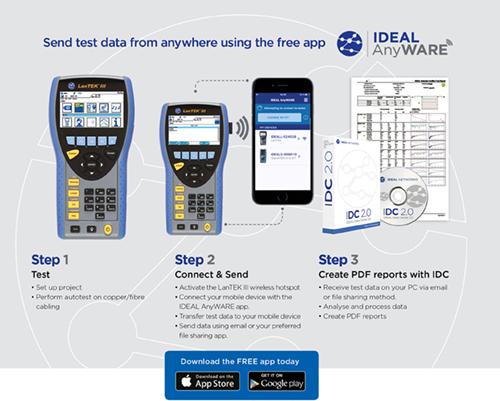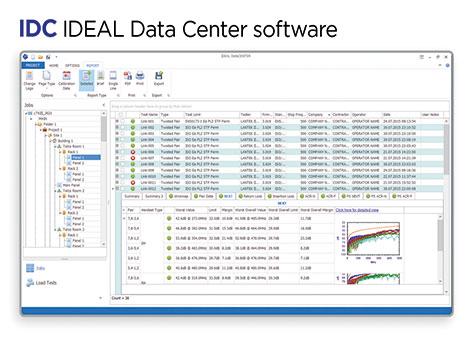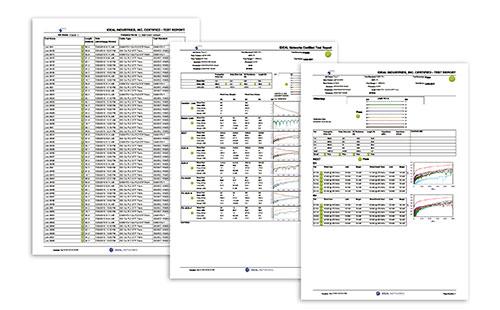Kérdése van? Segítünk!
1033 Budapest, Huszti út 52.
Nyitva tartás:
H-P7:30 - 16:00
| Gyártó: | |
| Cikkszám: | R164010 |
| NEW-NETWORK raktár: Figyelem! A készletinfó csak tájékoztató jellegű! Pontos raktárállapotot a rendelés visszaigazolásban, vagy előzetesen elérhetőségeinken tudunk adni. Raktáron: 3-7 munkanap, Nincs készleten,rendelésre: visszaigazolás szerint | Nincs készleten, rendelésre |
| Gyártó raktár: | Raktáron |
A csomag tartalma
Includes two multimode FiberTEK IV modules, two single-mode FiberTEK IV modules, lockable semi-rigid carrying case, SC, FC, ST adapters for modules (2 ea.), SC-SC patch cords, 6 x 9μm SMF, 6 x 50μm MMF compliant to ISO/IEC 14763-3 standard, quick reference guide.
Termék specifikáció:
Működtetési környezet: ideálisan 23 +/-1°C, 10 perc bemelegedés után
Tesztelési sebesség: 8 sec Autotest minden szálra/szálpárra (Bi-Directional mérésnél ez az idő a duplája)
Bemeneti csatlakozó felület (Meter egységen): univerzális adapterek 2.5 mm (ST, FC, SC, E2000) és 1.25 mm (LC, MU) ferrule átmérőjű csatlakozókhoz
Kimeneti csatlakozó felület (Source egységen): univerzális adapterek 2.5 mm (ST, FC, SC, E2000) és 1.25 mm (LC, MU) ferrule átmérőjű csatlakozókhoz
Szál típus: 9/125 SM és 50/125, valamint 62.5/125 MM
MM fényforrás típus és mód: 850 nm LED és 1300 nm LED
SM fényforrás típus és mód: 1310 nm Laser és 1550 nm FP laser
MM fényforrás hullámhosszok: 850 +/- 20 nm, 1300 nm -35 - +30 nm
SM fényforrás hullámhosszok: 1310 +/- 20 nm, 1550 +/-30 nm
Jelszintek light source módban: MM 850 nm 20-23dBm, MM 1300 nm -15 - -20 dBm, SM > 7 dBm
Hossz mérés: MM 0-7500 m, SM 0-20000 m
Hossz mérés pontossága: +/-1.5 m, ill. 2%, minimum hossz 2 méter
Power meter típus: InGaAs
Jelerősség mérés tartomány: 0 - -55 dBm (850 nm), 0 - -60 dBm (1300/1310 és 1550 nm)
Jelerősség mérés pontosság: +/-0.25 dB -20 dBm-en, FC adapterrel kalibrálva
Megjelenítési felbontás (jelszint/csillapítás): 0.01 dB vagy dBm
FiberTEK IV
A FiberTEK IV segítségével multimódusú és/vagy monomódusú száloptikai linkek mérése válik lehetővé a vonatkozó szabványoknak megfelelően, immár opcionálisan Encicled Flux mérési metódus kompatibilitással.
A fényforrás látható fény kibocsátásával vizuális hibameghatározásra is lehetőséget biztosít (szál törés, csatlakozó sérülés).
A FiberTEK IV Tier1 szintű optikai csillapításmérést tesz lehetővé (dB).
Elérhető multimódusú (850 és 1300 nm) és monomódusú (1310 és 1550 nm) adapterekkel, melyek a LanTEK IV mérőműszerre pattinthatóak.

Teszteredmények elérése ott és akkor, amikor Ön akarja
Az Ideal AnyWARE app segítségével megoszthatóak munkatársakkal vagy akár az ügyfelekkel/hálózat tulajdonosokkal a teszteredmények, mindenféle nehézkes adathordozási és adatküldési procedúrák nélkül
A részletekért kérjük kattintson ide

Az IDEAL Data CENTER (IDC) szofter segítségével rendezetten, hetékonyan és pontosan nyilvántarthatja, tárolhatja, riportolhatja és karbantarthatja a készülékről letöltött méréseit. 3 különböző formátumban (summary, brief, full) tud pdf formátumú jegyzőkönyveket generálni, illetve CSV formátumú adatexportra is van lehetőség.
A részletekért kérjük kattintson ide.


| FAQ | |
| Q | What is the difference between single-mode and multimode fibre? |
| A | Multimode fibre has a larger light carrying core of 50 or 62.5 microns compared to 9 microns for single-mode fibre. The larger core of multimode fibre captures more light than single-mode fibre allowing the use of low power LED light sources. The maximum bandwidth of multimode fibre is inversely proportional to length, i.e., doubling the length of a multimode cable reduces it’s bandwidth capacity by half. Multimode fibre is typically limited to lengths of 2,000 meters (6,560 ft). Single-mode fibre requires the use of higher power and more costly laser light sources but does not sacrifice bandwidth for distance. Single-mode fiber can be used at lengths of up to 40,000 meters (131,200 ft) while supporting 10 Gb/s data rates. |
| Q | Which LanTEK IV models support fibre testing ? |
| A | Both LanTEK IV-500 and LanTEK IV-3000 support FiberTEK IV |
| Q | Will LanTEK III support FiberTEK IV |
| A | Yes |
| Q | Will LanTEK IV support FiberTEK III ? |
| A | No |
| Q | Can I measure MPO connectors with FiberTEK IV |
| A | Not directly. Due to the still not very high repeatability when disconnecting and connecting MPO connectors, IDEAL still recommends to use so called fan-out cables from MPO to SC or LC |
| Q | Can I measure LC links with FiberTEK IV |
| A | Yes, there are optional adapters available |
| Q | Which products from IDEAL Networks test Tier-1 / Tier-2 ? |
| A | The OC I and FiberTEK IV test Tier-1. The OTDR II tests Tier-2. |
| Q | Do you need to do both Tier 1 (OLTS testing) and Tier 2 (OTDR testing) to complete a Tier 2 certification ? |
| A | Tier-2 certification is a supplement to Tier-1 certification meaning both an attenuation measurement with a power meter/light source (OLTS) and an OTDR measurement are required. It is for this reason many OTDRs have options for an integrated power meter. With the power meter built in to the OTDR, both measurements can be stored on a single instrument to simply reporting. |
| Q | When testing 2 fibres with an OLTS, can the fibres be looped at the far end so one person can test both fibres with a single tester or does each fibre need to me measured individually? |
| A | Looping the fibre is not a recognised method of OLTS testing because if the loss is too high you cannot know which fibre has a problem. When someone has an OTDR w/power meter the assumption is a stand-alone light source will be used at the opposite end of the cable to test each fibre individually. Having the OTDR w/ power meter is more convenient because the results for both Tier 1 and 2 tests can be stored on the same piece of test equipment. |
| Q | Is bi-directional testing required for OLTS & OTDR testing ? |
| A | Standards do not require bi-directional testing. For multimode fibre they require testing at 1 wavelength. 2 wavelength testing is optional. For single-mode fibre 2 wavelength testing is highly recommended for two reasons:First – single-mode cables can be long enough that the total attenuation can be very different at each wavelength because attenuation from bends in the cable depend on the wavelength. Second and more importantly - 2 wavelength testing can identify a bend vs a splice. Attenuation for a bend is different depending on the wavelength, but attenuation from a splice should be very similar at both wavelengths. The OTDR software assumes an event with similar loss at both wavelengths is a splice and an event with different loss values is a bend. This is the only way it can correctly identify a splice vs a bend. Bi-directional testing is useful for identifying mismatched fibre types. The loss with an OLTS or OTDR should be the same in each direction. However, if different types of fibre are connected together such as 50 & 62.5um multimode or single-mode fibre with different NA values (numerical aperture) the loss will be different in one direction vs the other. With an OLTS you see only the total loss, but a difference in measurements indicates there is a mismatch of sorts. An OTDR will show the location of the mismatch. A splice measured in one direction may show +0.5dB (gain) and in the other direction may show -0.3dB. When added together the result is -0.2dB which is the actual value of the splice.Standards do not require bi-directional testing. It is purely optional and used to identify issues like those mentioned above. |
| Q | Does Tier-1 testing require polarity and length measurements ? |
| A | There is no requirement to identify the polarity of the fibres, but this is a good reason for bi-directional testing. If the fibres are tested in both directions polarity does not matter. The cables are supposed to be installed so that the TX/RX is reversed but this is a documentation issue more than testing. The requirement to measure length depends on the standard being tested. TIA/ISO limit the length for horizontal fibre runs to 90m just like copper cable, so it is required to test length. TIA/ISO also have specifications for cable attenuation per km. For example multimode 850 must be 3.5dB/km or less - this is for the fibre only, not including connectors. Obviously to perform the calculation the cable length must be measured. This is difficult with an OLTS because it does not know how many connectors are in the link and are affecting the total loss. Practically speaking, an OTDR is the only way to do this measurement accurately. Some application standards like IEEE 10GBase-SX (10Gbps @ 850nm) only have a specification for maximum loss, not length. So as long as the loss is under the limit, cable length does not matter. There are big differences when testing TIA/ISO vs IEEE. TIA/ISO standards are written without reference to a specific application and are intended to provide installation guidelines for a generic cabling system that supports many different applications. IEEE test limits apply to each application and allow a user to ensure that a specific application will run on the cabling being tested. Cabling installers rarely know what application the network owners plan to use which is why installers test to TIA/ISO generic cabling standards. Most IEEE standards specify minimum cable distances for multimode fibre for the different grades:OM2, OM3, OM4 and OM5. This only means the bandwidth specified by the fibre grade is available to at least the minimum distance. It is not a distance limit and the bandwidth may be available at further distances for fibre that exceeds the minimum bandwidth ratings. |